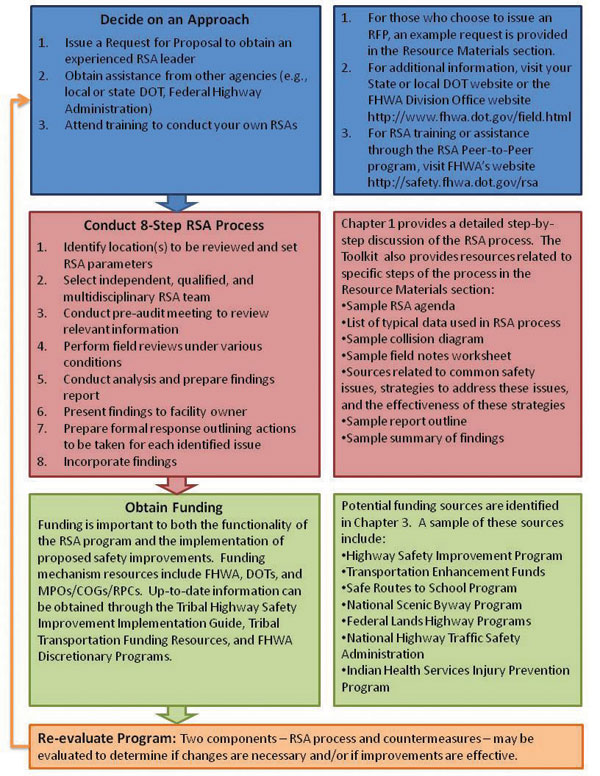This chapter summarizes the key points presented in the Toolkit, providing guidance regarding what can be done to move forward in establishing an RSA program and conducting RSAs. Further information related to the available references to aid in this process can be found in the Resource Materials section.
Where Do I Start?
The following are key elements of starting an RSA program.
- Coordinate with other Partner Agencies – Partnering with other agencies will prove beneficial for Federal and Tribal land agencies, as resources can be combined to target a central goal: improving roadway safety. Partnering opportunities should be considered not only when establishing an RSA program, but also when incorporating RSAs into the planning process. Partnering between State DOTs and FLMAs or Tribes can greatly improve communication and increase inter-agency participation and cooperation.
- Identify Problematic/High-Crash Locations – One of the key components of conducting a successful RSA is to select locations with safety issues where a benefit can be realized. For facilities on Federal and Tribal lands, it may prove difficult to adequately understand crash problems as data may be insufficient to identify trends. The best effort must be made to use available data and anecdotal information to select the most problematic and hazardous locations so that resources are used effectively and efficiently.
- Decide on an RSA Approach – Depending on experience, personnel, and funding, FLMAs or Tribes can consider several options to conduct RSAs. For those agencies with little or no experience, issuing a Request for Proposal would solicit an experienced outside lead for the RSA team (typically a consulting firm). Agencies with some experience and available resources may request assistance from the local or State transportation agency. Finally, for those agencies wishing to conduct RSAs on their own, training courses should be scheduled prior to actual field reviews. The National Highway Institute provides a training course (FHWA-NHI-380069) for performing effective RSAs.
- Obtain RSA Materials – Prior to conducting RSAs, agencies should become familiar with the overall process as well as specific details and issues to be looking for in the field. The Resource Materials section provides various resources with regard to demonstrating the usefulness of RSAs, assessing roadway safety, identifying potential improvements, and evaluating their effectiveness. Additional information and resources can also be obtained from attending one or more training courses and/or by visiting FHWA’s website.
- Schedule and Conduct an RSA – Once partnerships have been formed, locations have been identified, options have been addressed, and materials have been reviewed, it is time to get the RSA process underway. Example materials to aid in scheduling, conducting, and documenting an RSA are provided in the Resource Materials section. When introducing RSAs, consideration should be given to the “top down” approach: start with pilot RSA projects under an experienced lead and work towards developing a formal RSA policy. It is important to evaluate the overall experience of the RSA after its completion, noting the pros and cons and making adjustments as necessary when scheduling and conducting the next RSA.
Where Can I Find Support?
There are a number of supporting and participatory resources available to assist Federal and Tribal transportation agencies in improving safety by conducting RSAs. Resources are also available to provide updates on the “state of practice” for RSAs as well as information about safety issues and treatments being used by others. Several examples are provided as a starting point:
- Visit the RSA Website for more information.
- Utilize the RSA Peer-to-Peer Program.
- Contact a FHWA office, LTAP or TTAP, or State/local DOT.
- Subscribe to safety-related newsletters, such as the Road Safety Audit (RSA) Newsletter.
- Subscribe to relevant listservs, such as the Center for Transportation and Environment “Wildlife, Fisheries, and Transportation (WFT)” Listserv.
- Attend a safety conference, such as a Tribal safety summit, when it is held in your State.
Keep in mind that implementing changes may take time. Even seemingly minor changes may require coordination with multiple agencies and may result in a change in policies or practices. However, by working together, positive relationships can be established that will provide longer-term benefits in all efforts to improve safety…all it takes is commitment.

